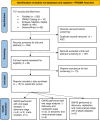Genome-wide association studies on periodontitis: A systematic review
- PMID: 39240858
- PMCID: PMC11379206
- DOI: 10.1371/journal.pone.0306983
Genome-wide association studies on periodontitis: A systematic review
Abstract
Objectives: This study aims to systematically review the existing literature and critically appraise the evidence of genome-wide association studies (GWAS) on periodontitis. This study also aims to synthesise the findings of genetic risk variants of periodontitis from included GWAS.
Methods: A systematic search was conducted on PubMed, GWAS Catalog, MEDLINE, GLOBAL HEALTH and EMBASE via Ovid for GWAS on periodontitis. Only studies exploring single-nucleotide polymorphisms(SNPs) associated with periodontitis were eligible for inclusion. The quality of the GWAS was assessed using the Q-genie tool. Information such as study population, ethnicity, genomic data source, phenotypic characteristics(definition of periodontitis), and GWAS methods(quality control, analysis stages) were extracted. SNPs that reached conventional or suggestive GWAS significance level(5e-8 or 5e-06) were extracted and synthesized.
Results: A total of 15 good-quality GWAS on periodontitis were included (Q-genie scores ranged from 38-50). There were huge heterogeneities among studies. There were 11 identified risk SNPs (rs242016, rs242014, rs10491972, rs242002, rs2978951, rs2738058, rs4284742, rs729876, rs149133391, rs1537415, rs12461706) at conventional GWAS significant level (p<5x10-8), and 41 at suggestive level (p<5x10-6), but no common SNPs were found between studies. Three SNPs (rs4284742 [G], rs11084095 [A], rs12461706 [T]) from three large studies were from the same gene region-SIGLEC5.
Conclusion: GWAS of periodontitis showed high heterogeneity of methodology used and provided limited SNPs statistics, making identifying reliable risk SNPs challenging. A clear guidance in dental research with requirement of expectation to make GWAS statistics available to other investigators are needed.
Copyright: © 2024 Gao et al. This is an open access article distributed under the terms of the Creative Commons Attribution License, which permits unrestricted use, distribution, and reproduction in any medium, provided the original author and source are credited.
Conflict of interest statement
The authors have declared that no competing interests exist.
Figures
References
Publication types
MeSH terms
LinkOut - more resources
Full Text Sources


